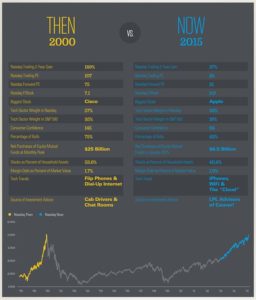Economic and Investment News Bits
- ”Fed forecasts for GDP indicate it will take a long time before we see an uptrend in inflation.” Despite this, many companies are generating excess cash beyond needs, and more is being returned to shareholders as dividends or used in financing mergers and acquisitions (M&A) – about $308 billion in M&A has been announced already this year, the third highest on record. Companies are generating more profits per employee than ever, and this is helping to support the stock market uptrend,” (Source: Federated Investors).
- The soaring dollar and plunging commodity prices (including oil) were a strong indication that the Fed might tighten interest rates prematurely. Last Wednesday’s announcement by the Fed would indicate otherwise. The directive from the Fed indicated “It will be appropriate to raise the federal funds rate when [the Fed] has seen further improvement in the labor market and is reasonably confident that inflation will move back to its 2% objective,” (Source: Jeremy Siegel)
- A July, 2014 survey found that 31% of U.S. households are providing financial assistance to adult children, a larger number than the 21% of households that are assisting elderly parents. (Source: American Consumer Credit Counseling)
- S. health care spending was $2.9 trillion in 2013. An estimated 75% of that is spent each year on medical care for chronic illnesses that are preventable, i.e., the illnesses are a function of often avoidable behavior including poor diet, smoking, obesity, excessive alcohol consumption, lack of physical activity, and poor oral health. (Source: Institute of Medicine)
- The average interest rate on a 30-year, fixed-rate mortgage is 3.78% today. From 1979-1990, the average interest rate was at least 10%.
- Among the world countries with the greatest percentage of debt-to-GDP, Japan is number one, with debt at 400% of estimated GDP. Not far behind are Ireland, Singapore, Portugal, and Belgium. Rounding out the top ten are Netherlands, Greece, Spain, Denmark, and Sweden. (Source: McKinsey).
Thought for the week
“Just remember, once you’re over the hill you begin to pick up speed.”
Arthur Schopenhauer, German philosopher (1788-1860)
Graph of the Week (CLICK TO ENLARGE) 
Here is a quick comparison of the NASDAQ in 2000 and 2015. Yes, the index has grown by 57% over the past two years, but this does not compare to the 189% growth in 1998-2000. The trailing price/earnings (P/E) ratio today stands at 25 while it soared to 107 in 2000. The bottom line is that this index has experienced some very positive returns lately, but valuations would not suggest a bubble. (Source: LPL)
This material is distributed by PDS Planning, Inc. and is for information purposes only. Although information has been obtained from and is based upon sources PDS Planning believes to be reliable, we do not guarantee its accuracy. It is provided with the understanding that no fiduciary relationship exists because of this report. Opinions expressed in this report are not necessarily the opinions of PDS Planning and are subject to change without notice. PDS Planning assumes no liability for the interpretation or use of this report. Investment conclusions and strategies suggested in this report may not be suitable for all investors and consultation with a qualified investment advisor is recommended prior to executing any investment strategy. All rights reserved.